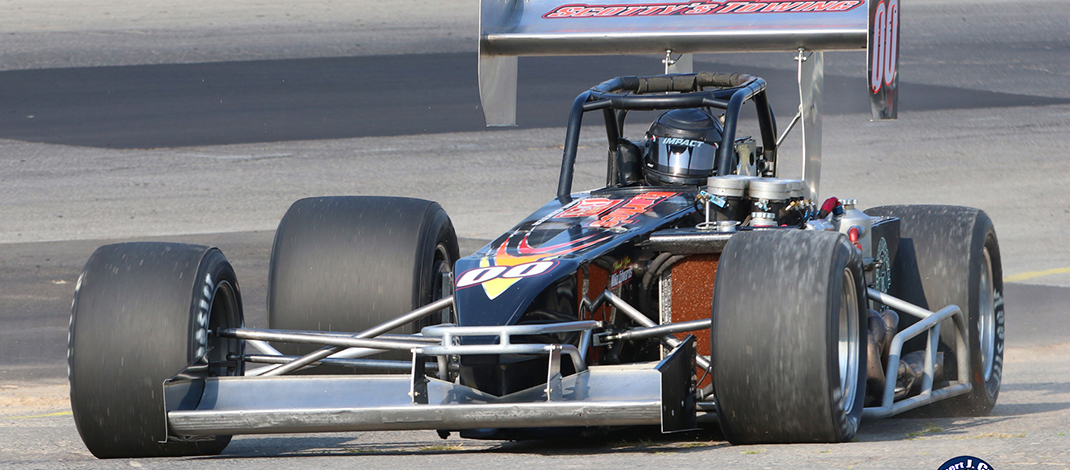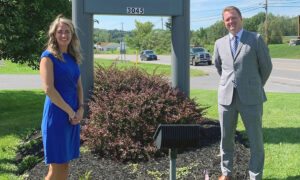Supermodified race car driver Joe Gosek still competing after more than four decades
By Stefan Yablonski
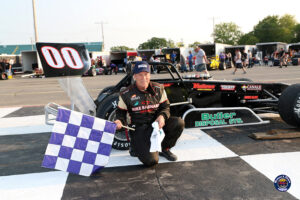 Joe Gosek has been going around in circles pretty much all his adult life. And, he has gotten good at it — very good, in fact.
Joe Gosek has been going around in circles pretty much all his adult life. And, he has gotten good at it — very good, in fact.
Joseph Edward Gosek, 67 — Double-O Joe — is a supermodified race car driver. For more than four decades, he and his Double-O race car have been a fixture at the famed Oswego Speedway (aka: The Steel Palace).
He has been victorious in numerous races at the track. He has won the crown jewel race, the International Classic, three times. He is also a multi-time champion on the touring International Supermodified Association.
A huge display in his eastside Oswego workshop is plastered with clippings highlighting his legendary career.
“There’s a lot of history on that board,” he said gesturing at the myriad articles and photos. “There have been just so many people involved, helping me over the years. Phenomenal times all over the country.”
“It goes back to when I started in 1980 — clippings from all over. I was always, you know, mechanically monkeying with something, bicycles, mini bikes and everything else. It transformed into getting involved with the race cars out here [at Oswego Speedway] in the early ‘70s,” he recalled as he skimmed the tableau.
“In 1974, I hooked up with Steve Gioia Jr. His father had a team back in the ‘60s. I hooked up with him and then helped him from ’74, I believe, through ’80,” he said. “And then Tony Osetek — I grew up on the hill with him with motorcycles — he decided he was going to get a [race] car. He had a local guy driving it. I was helping Steve. Tony was a firefighter with my father in the Oswego Fire Department and he helped my dad put up a garage. Tony didn’t have a garage to put his car in, his race car. My dad offered to let him put it in ours.”
“I was helping Steve Gioia across the river and then when Tony’s driver left; he asked Steve Gioia if he thought he should give me a chance,” he added. “So that’s where it all started … how many years ago? Oh, my God — that’s 42 years ago, 43 years ago?”
When did he race last?
“Recently? Saturday night [he placed in the top 10 of the 50-lap Novelis Supermodified feature on June 10 and on June 24),” he smiled. “So I’m still going. Back in the day, like in the ‘80s, we would go to different race tracks with our cars — we’d travel. Now I’m doing just Oswego.”
“I won the Triple Crown: Star Speedway Classic (Epping, New Hampshire), Sandusky (Ohio) Hy-Miler Classic and Oswego Classic. That was, I think, in ’91. Won the three Classics that were out there,” he said.
Changes
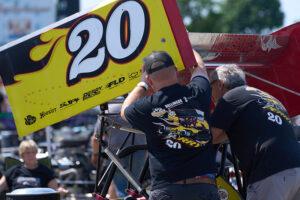 “Things have changed. Changed tremendously,” Gosek mused. “The composition of the tires; the technology involved in everything — everything’s evolved. The speeds, the motors, the technology, the cars — everything’s changed. Yeah, it’s a lot different than I remember from when I started, that’s for sure!”
“Things have changed. Changed tremendously,” Gosek mused. “The composition of the tires; the technology involved in everything — everything’s evolved. The speeds, the motors, the technology, the cars — everything’s changed. Yeah, it’s a lot different than I remember from when I started, that’s for sure!”
The competition is more spread out because of the technically advanced teams, he said, adding, “It’s not as even of a playing field than it used to be, I think. The rules are quite a bit different these days as well.”
He said they used to build their own stuff.
“Build your car, build your own engine. Now I know guys paying $45,000 or $50,000 for engines. You don’t build your own any more,” Gosek said.
The one he got is one that he had built by an engine builder, he explained.
“But the parts were used. A new set of cylinder heads is probably like $8,000. I bought mine for $4,000. It’s a good set,” he added. “Some guys out in Michigan are paying $45,000 or $50,000 for a complete motor. We probably put ours together for, I don’t know, 15 or 20 grand maybe.”
Volunteers / Sponsors
“Volunteers help out; they don’t buy much, but they help. Danny [Harrington] will buy something from time to time. Just not big ticket items, you know. But like $200 here or there,” Gosek said. “I got Danny and two other guys, one’s retired. They’re all late 60s, early 70s. We don’t pay anybody — I pay their way in, that’s about it.
“I have some great sponsors — that’s how I do it, not out of my pocket. I work at the nuclear plant [Constellation] to support my family, my two girls and my wife. I can’t be putting, you know, $500 a week into my ‘hobby.’ It costs $1,000 a week for tires to race.”
Racing tires are a lot softer than regular tires — “if you ran that out on the street you’d wear the thing out in about a week,” he said.
So, how many tires does a race car driver go through?
“In a season? Say we have 10 races and four tires a race — that’s 40 tires times $250. So that’s about $10,000. Everyone has to run the same tires, same size engine — different configuration but it can only be so many cubic inches,” he said.
Two major sponsors
“Burke’s Do It Best Home Center — they came along just as friends back in the ‘80s — they still sponsor me. They pay for tires every week; not all of them.
“Between Burke’s and Butler Disposal, he’s big; they are my two main sponsors. Vashaw’s Collision, he does paint work for me and sponsors us. Oswego County Monuments a little smaller than Vashaw, but they help out. And Canale Insurance up on Albany [Street], they are all helpful. WestAuto, some friends I have up in New England, they help out.”
But as far as personnel, you couldn’t afford to pay anybody to do it. Some of the teams can, they have the finances that can support that, he explained.
“The racing was slower back then — but it was better. It was better racing as far as I’m concerned,” Gosek said. “It’s just so different now; it’s so sophisticated compared to the way it was.”
The crowds are sparse. It’s not like back in the ‘old days.’
“We used to pack that place — 3,000 – 4,000 people. A lot of younger fans, too,” he said. “Not that many kids [are] involved anymore like us when we were growing up. Kids flocked to that race track; Saturday night was a big event. It’s not like that anymore. It’s sad. I just think there are so many other options for kids these days.”
Young racers
“I’d say most the guys up there [Oswego] probably haven’t raced 15 years and I’ve raced more than 40. They are all around their 30s, but there are some in their 40s and a few younger — like Tyler Thompson. He won a classic. He’s only in his early 20s.” Gosek said. “It’s getting to be a young man’s game, really. It really is. At this level, we can still be competitive but it’s still really a lot kids, younger drivers.”
“Kids are started at 5 years old 6, 7, 8 years old. They are driving go-carts and you watch them and it’s like ‘holy … they are good.’ I didn’t start race car driving until I was 23! So they are that far ahead. There are a lot of young talented kids out there — they can drive!” he added.
End of an era?
This has been “a hobby” since he started.
“You couldn’t make a living driving one of these. I appreciate all my sponsors. The guys in Indy and NASCAR, they drive professionally and get paid well. But this is called your Saturday night racing,” he said. “A hobby, it’s expensive. It’s got a lot more expensive. We used to do it for, probably, I don’t know, a quarter of the money — half the money you spend now. You could build all your own stuff back then out of junk yard parts and everything else. Now technology has taken over; it’s evolved into a more sophisticated game and the problem is the prices stymie the everyday guy because they just can’t afford to do it. Back in the day, up here in the ‘60s, the ‘70s there were drivers from all over; there were 50, 60, 70 cars from all over. Now days, you’re lucky if there are 30, you know.
“I’ve actually talked about this being my last year. At what point is enough is enough? I don’t know. I still enjoy it. But you want to be competitive, too. You gotta be competitive, but if you have to spend $50,000, $60,000 to be competitive that’s when we’re out. We’re not doing that; just going to keep plugging away and getting good finishes. At the end of the year, you never know.”
Gosek said he owns the car. But the engine, “what we did when we bought it, it was $30,000 without an engine — we had five people who were good friends, part of the racing team, that kicked in five grand each.
“So, we’ve got six guys with five grand each. When we’re done with it, I will probably sell it and if I get back half of that — I’ll give them back half of what they put in when they invested. So after 10 years of watching the car, helping the car, being a part of the team, they spent 25 hundred bucks.”
Joe Gosek Career Highlights and Records
•In 1991, he won the Triple Crown of Supermodifieds: Sandusky (Ohio) Hy-Miler Classic; Oswego Budweiser; and International Classic and Star (New Hampshire) Classic. He’s one of only four drivers (including Syracuse Hall of Fame member Doug Heveron) to accomplish this feat.
•Raced a supermodified on the one-mile Phoenix International Speedway oval at speeds of more than 150 mph, finishing fifth in the 25-lap Copper World Classic in 1992.
•Two-time winner (1986, 1988) of the New York State Ground Round Supernationals Classic during SuperDIRT Week.
•Three-time winner of supermodified’s most prestigious event — The Oswego Speedway Budweiser International Classic in 1991, 1992 and 2002.
•In 1997, he was named March of Dimes Sports Spectacular New York Athlete of the Year.
•Also in 1997, he raced in the USAC Silver Crown division at Indianapolis Raceway Park, competing against Tony Stewart and future NASCAR Cup contender and 2008 Daytona 500 winner Ryan Newman.
•In 1999, Gosek drove “The City of Syracuse” entry, owned by Syracuse businessman Ron Mucci in the USAC Silver Crown series at Walt Disney World Raceway in Orlando, Florida.
•Two-time ISMA (winged) supermodified series champion, 1987 and 2000.
•Twenty wins in the ISMA series, placing him fifth in all-time ISMA feature wins.
•Two-time Oswego Speedway track champion — 2002, 2011.
•In 2014, Gosek’s 42nd Oswego Speedway feature win eclipsed Syracuse Hall of Fame member Nolan Swift (41 wins).
•At the end of 2022, Gosek remained at the very top of the list of Oswego Speedway all-time top five finishes with 235 and all-time point standings with 35,368.
•His last Oswego win was in 2019 — at 63 years old.
•Gosek plans to compete weekly in 2023 – his 43rd consecutive year.
Double ‘O’
Race car driver Joe Gosek is also known as Double-O Joe.
The double “0” kind of rhymes with Joe, he explained. “The first car I drove, my buddy, Tony Osetek, had bought it from a guy in Ohio. That was the number of the car when he bought it. Just a coincidence —when I started driving it for him that’s the number it was and people right off the bat put a moniker of it — ‘Double-O Joe.’ That stuck with me and that’s the number I’ve always had. That’s just from the first car I raced at Oswego.”
His current “00” has been his ride since 2014.
“I think it is the oldest car up there,” he said.
He has had some accidents — “but none that majorly hurt me. We’ve been fortunate; nothing too bad. But, you know, stuff happens out there. Everyone’s in the same area, trying to do the same thing, looking for any opening, any advantage. There’s not a lot of room out there when people are going that fast,” he said.
Sponsorship
“I usually raise about $15,000 a year in sponsorship through the people that have been backing me for a long time,” Gosek said. “I am fortunate to have great people behind my effort. I believe it is quite a bit of sponsorship compared to most other teams.”
The sponsors get their names on the car, and usually on fire suit, too.
Their names are announced pretty much at the start of each race you compete in, he added.
“We take the car to their place of business for display to customers. Sometimes names are mentioned in the newspapers and other articles that you are in,” he said.
Indy 500 Memories
Supermodified race car driver Joe Gosek said he still recalls his run at Indianapolis 500.
“Of course, qualifying for Indy [1996] was a thrill. We’re fast at Oswego; Indy is fast at a whole different level.”
“I could write a book about what went on,” Gosek said of his Indianapolis 500 experience. “The speed was just incredible. I remember going wide open during the qualifying runs. It’s something I think about every year when Indy’s on.”
He had myriad problems at Indy. During the race, he lost the turbo boost. He was going about 220 and lost 3,000 rpm. The best he could do after that was barely faster than 200 mph, he recalled.
Gosek said he completed 109 laps and wound up with a 22nd place finish in his one and only start in the 500. “That’s not too shabby, right?” he asked rhetorically.
“I’ve been doing this for 40-something years; you can’t always recall all the neat times you’ve had and the people you met. Of course, the first big race that I won would have been the Oswego Classic — that one stands out. The classic is the ultimate win for cars like us. If you won the classic, you won the best race,” he said. “As a driver you adapt to different race tracks, different situations. I ran in Phoenix, Arizona, that’s a one-mile track that’s real fast. I forget how many races I’ve won out of town.”
What They Say About Joe Gosek
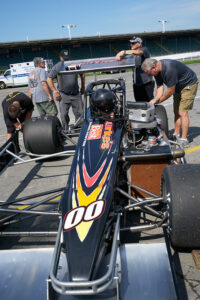 “Joe is the type of person that will do anything for you. He doesn’t know the word ‘no’ and he is willing to help out anyone that asks for it. This applies both for normal everyday stuff and especially at the track or in the race car shop.“He is extremely easy to work around and work for. In the race shop, the crew all works together under Joe’s direction. Joe is a machinist by trade and can make just about anything to fix and maintain the car. I’ve been with Joe since the early ‘90s and have loved every minute of it.
“Joe is the type of person that will do anything for you. He doesn’t know the word ‘no’ and he is willing to help out anyone that asks for it. This applies both for normal everyday stuff and especially at the track or in the race car shop.“He is extremely easy to work around and work for. In the race shop, the crew all works together under Joe’s direction. Joe is a machinist by trade and can make just about anything to fix and maintain the car. I’ve been with Joe since the early ‘90s and have loved every minute of it.
“I could write a book on all the fond memories over the years.”
— Danny Harrington, executive director of Harborfest and a volunteer with Joe Gosek’s racing crew.
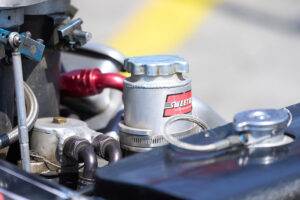 “It’s his drive and his passion for racing is definitely, I’d say, is the number one thing that has kept him going and made him so good.
“It’s his drive and his passion for racing is definitely, I’d say, is the number one thing that has kept him going and made him so good.
“His desire to win. People who aren’t racers think it is just a guy going around in circles in a car. Really, it’s people who are ultra competitive — that’s what Joe is. Joe is ultra competitive and he has a passion for racing. He’s a winner — it’s just something he has in him.
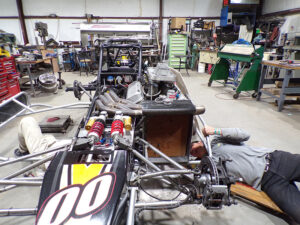
“On a Saturday, he might have had a tough week in the garage, maybe making repairs on the car — Joe doesn’t like to repair race cars, no one does. But come Saturday, that racer comes out and he’s at the track ready to go — it’s that desire.
“I’ve been with Joe since 1983 (Burke’s as a sponsor). I’m on his crew — the tire guy.
“Besides sponsoring Joe, Burke’s has been the official home center sponsor of Oswego Speedway. My dad started with the speedway and the Carusos back in the ‘60s.”
— Chuck Handley, co-owner of Burke’s and race director.
Gosek Nominated for the Greater Syracuse Sports Hall of Fame
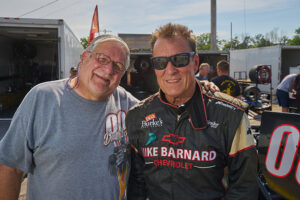
Oswego’s Joe Gosek, a 42-year supermodified racing veteran, was nominated for inclusion in the 2023 Greater Syracuse Sports Hall of Fame by Dough Caruso, a former co-owner of Oswego Speedway; former co-owner of Speedway Press, Inc.
Gosek, a lifelong resident of Oswego, lives with his wife, Vicki, a Delta Airlines flight attendant, and their two daughters, Piper and Remy. He is employed at the Constellation’s Nine Mile Point Nuclear complex in Scriba.
In the nomination, Caruso said Gosek is “one of the most prolific and talented race car drivers in the history of Oswego Speedway and well beyond.” He has been racing competitively for more than 42 years, starting at age 18 in Motocross.
However, Gosek didn’t make the cut for the hall this year.
“We didn’t make it this year. But we’ll try again next year,” Caruso vowed. “I’m disappointed he didn’t make it — yes, I am. I did a lot of work on this. There was quite a bit involved.”
This isn’t the first time. Caruso actually nominated him back in 2016. So maybe the third time will be a charm, he added.
Caruso said he had a customer and friend who was on the board of directors for GSSHOF.
“He helped me get four other drivers into the hall of fame. Unfortunately, he has passed away. I have no one now who will carry the ball forward,” he said. “So, yeah, I was disappointed. But I can’t say anything bad because the fact of the matter is everybody that got in is worthy, you know. It’s not like he could replace somebody else — it’s not like that.”
Perhaps the greatest highlight of Gosek’s career was in 1996, when he qualified and raced in The Indianapolis 500, Caruso said.
“His gutsy effort to compete in this event exemplifies Joe’s career-long determination to succeed. Failing to get his original ride up to speed during the month of May at Indy, Joe was hired by another car owner and a last-minute attempt to qualify for the biggest race in the world was played out in front of thousands of viewers on TV as Gosek put his new ride solidly into the field of 33 — with very little practice,” Caruso said.
“Joe Gosek has become a respected competitor as well as a gracious spokesperson and representative of the sport. From the beginning in 1980 when he graduated from crewman to a supermodified driver, Joe has been dedicated to giving his very best effort each time he has wheeled a race car onto a speedway — in Oswego, Indianapolis or anywhere else in the United States and Canada. Most important, he has never lost sight of who he is or where he came from,” Caruso said.

